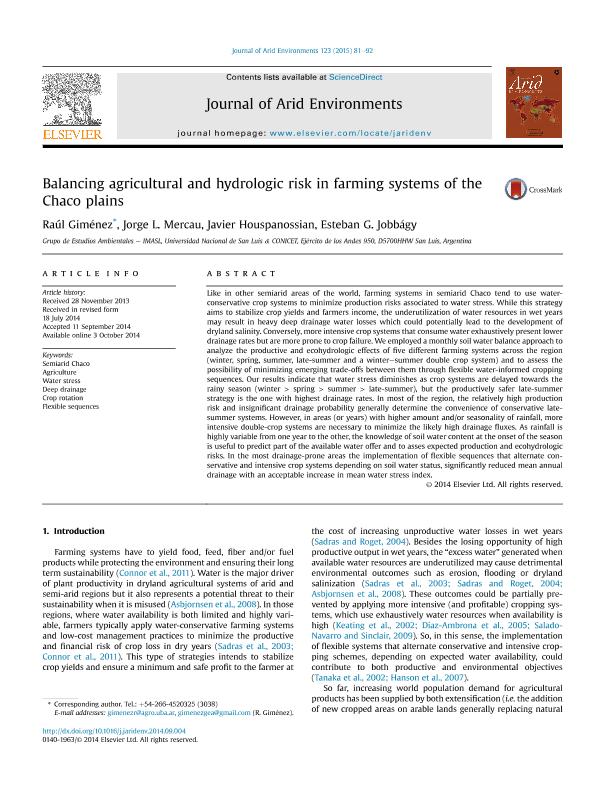Artículo
Balancing agricultural and hydrologic risk in farming systems of the Chaco plains
Fecha de publicación:
10/2015
Editorial:
Elsevier
Revista:
Journal Of Arid Environments
ISSN:
0140-1963
Idioma:
Inglés
Tipo de recurso:
Artículo publicado
Clasificación temática:
Resumen
Like in other semiarid areas of the world, farming systems in semiarid Chaco tend to use water-conservative crop systems to minimize production risks associated to water stress. While this strategy aims to stabilize crop yields and farmers income, the underutilization of water resources in wet years may result in heavy deep drainage water losses which could potentially lead to the development of dryland salinity. Conversely, more intensive crop systems that consume water exhaustively present lower drainage rates but are more prone to crop failure. We employed a monthly soil water balance approach to analyze the productive and ecohydrologic effects of five different farming systems across the region (winter, spring, summer, late-summer and a winter?summer double crop system) and to assess the possibility of minimizing emerging trade-offs between them through flexible water-informed cropping sequences. Our results indicate that water stress diminishes as crop systems are delayed towards the rainy season (winter > spring > summer > late-summer), but the productively safer late-summer strategy is the one with highest drainage rates. In most of the region, the relatively high production risk and insignificant drainage probability generally determine the convenience of conservative late-summer systems. However, in areas (or years) with higher amount and/or seasonality of rainfall, more intensive double-crop systems are necessary to minimize the likely high drainage fluxes. As rainfall is highly variable from one year to the other, the knowledge of soil water content at the onset of the season is useful to predict part of the available water offer and to asses expected production and ecohydrologic risks. In the most drainage-prone areas the implementation of flexible sequences that alternate conservative and intensive crop systems depending on soil water status, significantly reduced mean annual drainage with an acceptable increase in mean water stress index.
Palabras clave:
Semiarid Chaco
,
Agriculture
,
Water Stress
,
Deep Drainage
Archivos asociados
Licencia
Identificadores
Colecciones
Articulos(IMASL)
Articulos de INST. DE MATEMATICA APLICADA DE SAN LUIS
Articulos de INST. DE MATEMATICA APLICADA DE SAN LUIS
Citación
Giménez, Raúl; Mercau, Jorge L.; Houspanossian, Javier; Jobbagy Gampel, Esteban Gabriel; Balancing agricultural and hydrologic risk in farming systems of the Chaco plains; Elsevier; Journal Of Arid Environments; 123; 10-2015; 81-92
Compartir
Altmétricas




